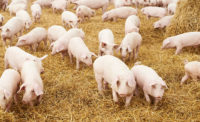Average U.S. pork production during the 12 months through February was up 3.5 percent from one year ago. The ITR Checking Points system indicates production could accelerate upward during at least the near term. U.S. food production, however, is expected to grow at a slowing pace during the second half of 2018, limiting the upside potential for U.S. pork production in that time period. Strong consumer trends, such as rising wages and disposable personal income, are providing support for the pork industry within the U.S.
Internationally, recent decline in the value of the U.S. dollar is supporting exports of pork to foreign countries (approximately one quarter of pork produced domestically is exported). U.S. Meat Export Federation data showed pork exports from mid-January to mid-March were up 5 percent from one year ago. But China recently announced a 25 percent tariff on a list of American products, including pork. The pork industry could suffer job losses and businesses could realize lower profits because of the tariff. Announcement of the tariff has already resulted in the largest weekly drop in net pork sales to China since 2016.
Beware of linear budgeting during this period of the business cycle as production will likely rise at a slower pace in 2018 than 2017. NP




Report Abusive Comment